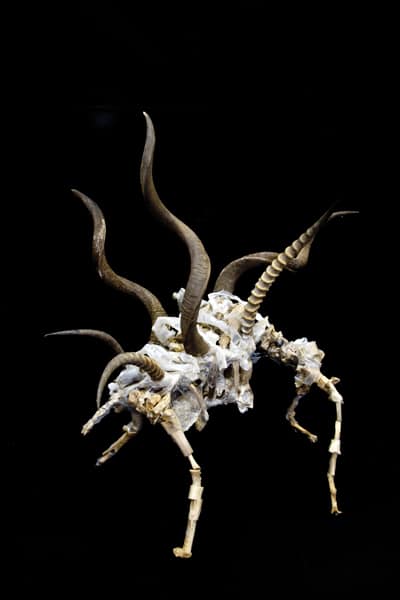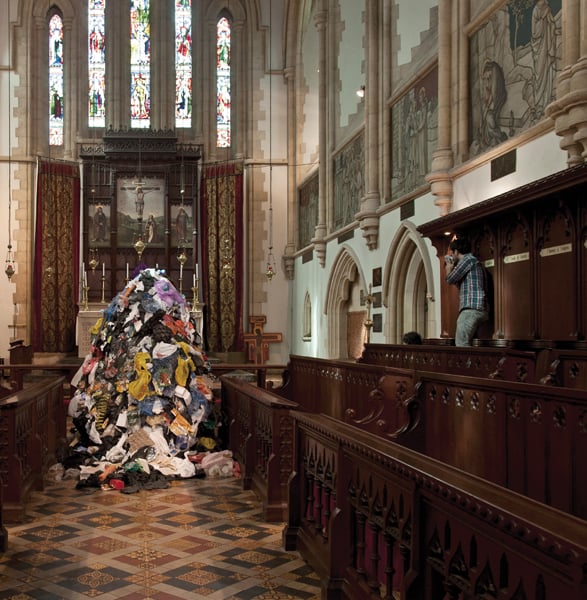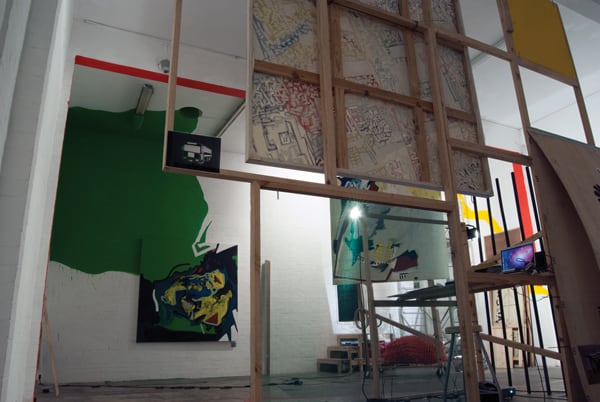TRASHED
YOUNG SCULPTOR FRANCOIS KNOETZE REAPPROPRIATES RUBBISH TO CREATE ‘GRIMY TREASURES’, WRITES GENNA GARDINI.

 top – bottom Francois Knoetze, Untitled, 2012, melted plastic and
top – bottom Francois Knoetze, Untitled, 2012, melted plastic andwild animal bones. Photo: Paul Greenway; Francois Knoetze, Refus,
2012, performance piece/short film. Photo: Chris de Beer.
‘I suspect I will get horribly drunk,’ laughs twentythree-year old sculptor Francois Knoetze when asked about his plans for the immediate future. At the time of writing, the soon-to-be Rhodes BFA graduate is applying the finishing touches to his final exam exhibition, Oikos: An Odyssey, while also preparing to leave his long-time home, Grahamstown.
The young artist, who came to wider attention as a finalist in the 2011 Absa L’Atelier and Sasol New Signatures competitions, has lived in the small Eastern Cape town for most of his life. Like most locals, Knoetze has mixed feelings about abandoning the place. ‘At times, the fact that it is comparatively secluded from the South African art world seems to place one at a disadvantage when trying to get your work seen,’ he muses. ‘On the other hand, the town is like a petri dish, with a population from all corners of the country, making it seem bigger than it is.’
It was in the art department of Rhodes University that Knoetze honed his skills in what he refers to as assemblage sculpture. ‘I had only ever painted before university,’ he explains.
I feel that the emphasis on adopting an experimentational approach, which is encouraged in the first few years of study at Rhodes, helped me to broaden my horizons in terms of exploring different mediums. Sculpture seemed to provide the most room to play and work through ideas quickly. I enjoy the immediacy of working with
my hands, and the thrill of solving problems in a systematic and pragmatic way. Working with ‘non-traditional’ sculpture materials makes one feel somewhat like an inventor. There is no manual for making art with trash or found objects, simply because the variety of things you can use is so immense.
Knoetze attributes his attraction to these ‘nontraditional’ materials to his upbringing. ‘My father and grandfather have instilled in me a sense of pragmatism and frugality which are inseparable from my daily processes of making art,’ he says. ‘My mother’s love of the arts has also had a huge influence on me. As a young child, I would spend hours paging through threadbare art books of old masters which she had recovered from a pile discarded by the public library destined for pulping. I remember being perplexed by the fact that someone would throw something as precious as those books away.’ Knoetze’s interest in saving items others might discard was further developed in his childhood: ‘Eyeing out a good buy is, so to say, in my blood. My grandfather often buys broken appliances and furniture from auctions with the intention of fixing them up, and bragging about how little he paid for them once fixed. Learning to see objects for what they can potentially be instead of what they presently are has been a huge part of my approach to sculpture.’ This belief in the potential, as opposed to the prescribed, value of things is perhaps clearest in Knoetze’s 2012 Refus. The performance piece and short film follow a giant moving sculpture made from Knoetze’s material of choice, trash, as it wanders Grahamstown. ‘Refus is the story of a little slice of the local dump’s transformation from inanimate waste, to mobile, sentient creature,’ explains Knoetze. In the film, that creature skulks around town looking like the love child of Stig of the Dump and a Spirited Away demon, amusing and terrifying locals. ‘As could be expected, the townsfolk are less than hospitable to the resurrected, wandering pile of rubbish, and after being ridiculed, rejected and harassed, Refus is captured and ultimately executed by being converted into a block of compressed cans.’
The piece caught the eye of choreographers Gavin Krastin and Alan Parker and digital artist Rat Western, who asked Knoetze for permission to reuse Refus in their 2012 National Arts Festival performance art installation Discharge. This isn’t the first time that Knoetze has worked with theatre-makers: ‘After matric I took a gap year, working as a stage rigger in London,’ he explains. ‘But as a Grahamstown local, I have been fortunate enough to be exposed (willingly or by force) to world-class theatre presented by the NAF and Rhodes drama department from a very young age.’ When asked if he thinks this background of working in the performing arts has influenced his work, though, Knoetze is unsure.
Since I have only been involved in theatre productions as a set or puppet designer, with relatively little creative freedom, I don’t feel that the work I have done in that capacity has influenced my work greatly. I would rather attribute the performative qualities of my work to the hours spent watching movies and theatre pieces, and immersed in role-play computer games as a child (if I’m honest, also as an adult). I often attempt to approach a piece from the first-person perspective of an imagined spectator. Similar to the role of a player in a game, I like to place the viewer in a position where they are a character, no matter how obscure, moving around a space, making decisions, and interacting with artificially intelligent character (actors).
Knoetze’s preferred materials, perhaps like his viewers, seem to be those with their own particular history. ‘As Gillian Whiteley notes that “when paper is soiled or lacerated, when cloth is worn, stained”, torn, when wood is split, weathered, or patterned with peeling coats of paint, when metal is bent or rusted, they gain connotations which unmarked materials lack’, he quotes. ‘I have tried to reach a level of acquiescence with the dirtiness of being human. With regard to the current global environmental crisis, I feel that we could learn a lot from the people who are forced to survive off our rubbish. Although I am always well aware that I am there by choice, not necessity, I find it strangely satisfying to dig around a dump for grimy treasures.’
For more information on Knoetze, see http://francoisknoetze www.carbonmade.com.
Genna Gardini is a writer and poet based in Cape Town.
THE LIMITATIONS OF THE ‘HALF’ AND ‘WHOLE’
ALEXANDER OPPER PROPOSES A CASE FOR PRAXIS IN THE WORK OF QUINTEN WILLIAMS.
 Quinten Williams, Some Combinations, 2012, exhibition view, Substation, Wits University. Image courtesy the artist.
Quinten Williams, Some Combinations, 2012, exhibition view, Substation, Wits University. Image courtesy the artist.In the exhibition Some Combinations, at the Substation earlier this year, Quinten Williams unfolded one ‘half’ of what is required for the MA in Fine Arts at the University of the Witwatersrand. The exhibition component of his work pulls aspects of Johannesburg’s ‘human and non-human bodies’1 and the transient relations between these into the white cube. These urban ‘takes’ occupy the gallery in various ways: sometimes literal (the driftwood-like residue of what the city discards); as translations (paintings, objects and ensembles); analogously (scaffolds and suggestive ‘architectures’); and as deadpan dérive-driven sonic and video captures of marginal pieces of the city. However, the ‘whole’ represented by the exhibition does not attempt a complete depiction or simplification of the city.
The City as Medium and Accomplice
Much has been written about this particular ‘elusive metropolis’. Williams’s Merzbau-like urban inhabitation of the gallery underlines a number of Johannesburg’s many elusive environments by intensifying them. He focuses on the marginal and unspectacular, reconfiguring disparate and obscure parts of the city, and artificially bringing some of Johannesburg’s urban inconsistencies close together. These chosen fluid and atmospheric aspects – captured, collected and translated – suggest the solidification of a series of cinematic jump-cuts.
A haunting fusion of in-betweens, the result is an intuitive freeze-frame of the artist’s grappling with, and complication
of, the intangibilities of ‘environments, praxis, and multimodal art research.’2 During Williams’s on-going adjustment of the exhibition’s construction – over two weeks – the gallery was publically accessible, blurring the linearity of ‘setting up’, ‘showing’ and ‘tearing down’. In the show Williams avoids simple modes of listing, quantification and judgment. He counters the neat but problematic conventional making of physical work and its subsequent writing up. Instead, the city becomes an accomplice of the work resulting in frictions, exacerbations, reversals and productive accidents. Similarly, via the city’s contextual complicity, the author becomes the voluntary accomplice, in turn, of the city. This ‘pact’ enriches and extends the deand re-constructed dialogue between artist and city – both in the gallery-scape and the city-scape.
The multi-layered meanings and potential readings embedded in the exhibition invite a complication of seemingly never-ending contested positions around notions of authorship. Williams’s emergent artistic stance leans towards but simultaneously complicates Roland Barthes’s famous essay, The Death of the Author (1967), insofar as it presents a concrete example of the importance of the ‘reader’ or ‘user’ of the artist’s open-ended versions of Johannesburg as a particular text/place. We see interesting correlations between his reconfiguration of parts of the city and the way the real city is used and ‘written into being’3 in an everyday sense. The adjustments Williams makes to the evolving construct of his exhibition echo the way that users of the actual city appropriate and customise its fabric, to make it work for them, and not the other way around.
Mark-Making and the Complicity of Context
Williams intelligently exploits various media in the space of the exhibition to construct a series of visual, sonic, painterly
and installation-driven continuities and disruptions. The shortcomings of certain media are addressed by the strengths
of others so that each medium achieves a collaborative or partauthorial role, and the ostensibly loose multi-media choreography of reconfigured urbanisms avoids both the lure and the trap of an easy and exhaustive interpretation. Williams’s role in the project is that of a director who rearranges his mode of urban collecting (of material) into an arrangement of potential experiential immersion for the visitors of his ‘city’ within the gallery. His sophisticated understanding of the media at his disposal allows the artist to drive home the significance of contextual conditions – and his experiential connectedness to these – in his practice. Through both situational and more focused walking, Williams makes a ‘deal’ with the contexts that he crosses and captures. He does not necessarily ‘belong’ to the people-produced ‘infrastructures’4 of the sites of his walked research, but he is clearly not naïve as to how the insertion of his own body into – and his participation within – these mostly liminal spaces alters and even threatens their finely tuned and mostly invisible codes and dynamics.
Williams’s work has, up till recently, oscillated between drawing and painting. The process towards his MA has catalysed and accelerated the broadening of his mark-making practice. This has resulted in a self-reflexive trajectory towards a multi-modal praxis, at the core of which lies the importance of the context as ‘collaborator’. The body of work produced for his Honours degree show, Environments (2009), relied on a more distanced view of the city and subscribed to a reduced palette of grey, black and white. As aesthetically seductive as the earlier body of work may be, I believe that the immersive approach that structures his current praxis has resulted in a promising progression. Williams’s transition from the conventional limits of the picture plane in the earlier work, to a re-scripting of the gallery space, alludes with quiet sophistication, to Gordon Matta-Clark’s more violent and physical attempts at the disruption of the politics enmeshed in the architectural envelope and the urban environment, in the socio-political context of another gridded city – New York, in the 1970s.
The Praxis of Practice: Johannesburg Boogie-Woogie
I cannot help recalling here the memorable works of Moshekwa Langa, Collapsing Guides (2000–3), at the Johannesburg leg of Africa Remix (2007). The art-historical suggestive, playful and ironic fallout of modernist references in Williams’s and Langa’s work is undeniable. However, each develops a sophisticated language of their own, beyond stylistic concerns. Langa’s geographical flattening of his mind-maps employs the materiality of the residual as medium, breaking with the canons of the canvas and its usual ‘attachments’. The result is an evocative cartography of imagined and lived projections of routes and scapes and combinations of both. The crossings of borders and intersections of cultural difference which Langa’s works allude to seem to take physical shape in Williams’s topographically experimental and reflective manipulations of pieces of the urban within the white cube. The lineage of the ‘city as accomplice’ has a long history. Just as New York invariably became an accessory to Piet Mondrian’s artistic growth in his own search for clarity of expression – exemplified by the late work Broadway Boogie-Woogie (1943) – so Johannesburg’s multiplicities have provided the liminal score for Williams’s emergent praxis.
The artist’s carefully translated yet open-ended interpretations of contextual conditions are a convincing example of the value of multimodal research and the significance of the practice-led. It highlights the all too often (locally at least) harped-on futility of the comfortable perception that two neat halves (practice and research) make a satisfactorily definitive whole. In a counterfoil to this, the captured, collected and reconfigured environment which results from the emergent process of Williams’s Some Combinations, not surprisingly, adds up to significantly more than the sum of its parts.
1. Gilles Deleuze and Felix Guattari’s multivalent understandings of the around notions of ‘bodies’ forms an important part of Williams’s research.
2. Excerpt from the written component of the artist’s dissertation.
3. Lindsay Bremner uses this phrase in her book, Writing the City into Being: Essays on Johannesburg 1998–2008 (2010).
4. Abdoumaliq Simone, People as Infrastructure: Intersecting Fragments in Johannesburg (2004) challenges the usually narrow definition of infrastructure (as a collection of physical systems and networks, meant to serve the city and its users).
Alexander Opper is an architect, artist, writer and educator. He directs the master’s programme in architecture, in the University of Johannesburg’s Department of Architecture.
First published in Art South Africa Volume 11: Issue 02



